Technical article
Let's discuss the emission part (light source) of the system together.
Remember the overview of triangulation principles:
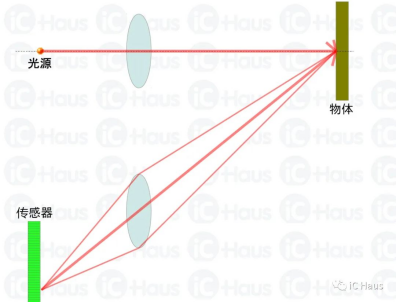
Triangulation sensors use a light source that is reflected off an object and directed toward the linear sensor. The object distance determines the angle at which the light is reflected, so changing the object distance causes the beam to reach a different location on the sensor. But instead of a single spot illuminating a single pixel on a linear sensor, the beam received is spread out (depending on the light source, object surface and distance, lens used, etc.), forming a pattern that in good conditions looks more like the following pattern:
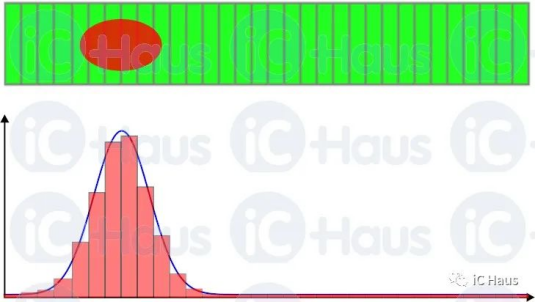
The signal described above is fairly easy to process, but in practice there are many factors that affect the shape of the signal curve. These factors include lens imperfections, target surface variations, vibrations, external light sources (such as ambient lighting), distortion/distortion or non-uniformity of light sources, etc. The diagram below shows what the actual signal might look like when these factors affect the system:
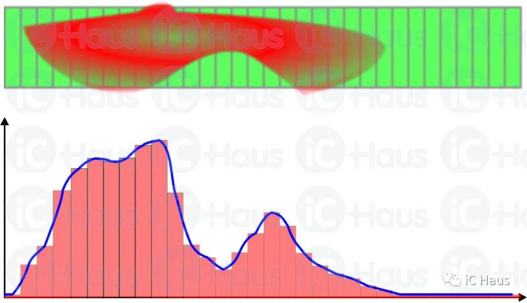
This is more challenging to deal with. The effect of target object change is difficult to avoid, because it is determined by the application, so a good sensor must compensate for this effect by improving the transmitter and receiver. In this article, we'll focus on how to improve the quality of lights, as well as suppress other (unwanted) lights.
Optical triangulation sensors primarily use LEDs or laser diodes as light sources. Each method has its own advantages and disadvantages, which we will briefly discuss.
For precise beams, such as those used in high-precision distance measurement sensors and surface flatness measurements, laser diodes provide the best results. The advantages and disadvantages of laser are clear at a glance:
+ Narrow and precise beam.
+ Specific wavelengths.
+ High Power: Easier to reach longer distances.
- High cost.
- Safety issues: eye safety, laser class, optical power control circuit, etc.
- Sensitive (more prone to damage) to ESD or other energy surges.
LEDs are often the simpler solution, especially in less demanding applications such as object presence sensors, automatic doors, etc. Some factors to consider when using LEDs as light sources:
+ low cost
+ high power achievable (depending on LED)
+ robust - relatively short distance
- light divergence/diffusion (wider angle)
- non-uniform illumination, divergence along a wider wavelength range.
If you decide on a laser diode solution, the laser power and wavelength must match the requirements of the application: the power must be high enough to reach the desired distance (and return to the sensor), and the wavelength must be highly reflective on the target object. Then, after selecting the laser diode, the appropriate driver must be carefully selected. Safety features need to be considered, precise control of laser current/power, etc. iC-Haus offers a wide range of laser diode drivers with different characteristics for different applications.
A simple solution is our iC-WK series, which is suitable for continuous wave (CW) laser operation (not pulsed operation). It is easy to use, cost effective, and offers built-in precise optical power control.
For more advanced solutions, the iC-NZN is an excellent all-rounder: it offers CW or pulsed operation, higher maximum current, automatic power or current control, over-current limiting, and more.
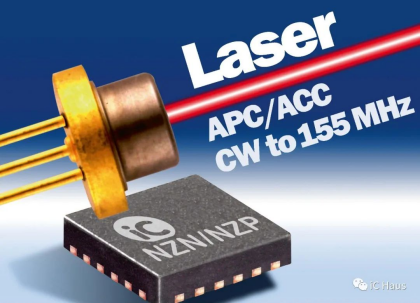
Both drivers can also be used to drive LEDs if you choose LEDs as the light source for the sensor.
There are many different LEDs on the market. It's easy to find very cheap LEDs, but they're usually fine for lighting purposes. LEDs used in sensors should have good characteristics, stable performance and low variability. Otherwise, each sensor will produce different results during mass production.
LEDs are manufactured in different technologies: the lower-cost traditional LEDs are volume light emitting LEDs, the slightly better ones are surface light emitting LEDs, and the newer high-end alternatives are point source LEDs.
The comparison table is as follows:
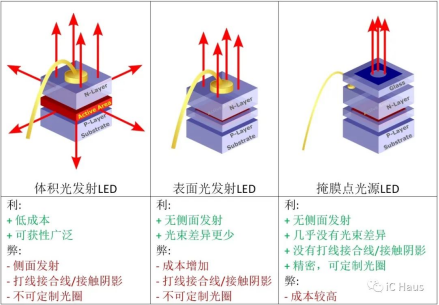
The iC-TL6 is our masked point source LED with excellent performance for a variety of applications including triangulation sensors: uniform illumination, no shadows from bond wires and contacts, circular beam (better match to sensor Circular optical lens in ), without stray light and reflections from lateral/side emission. It can reach pulse currents up to 1A and has an operating temperature range of -40°C to +125°C. This greatly improves the quality and uniformity of light received by the sensor, all in a compact SMD 1206 package.
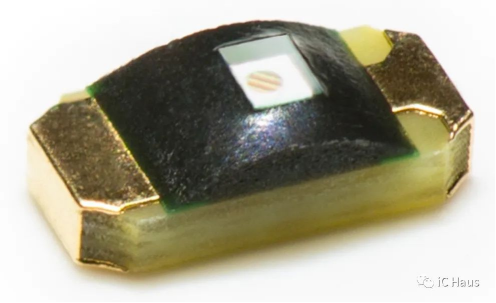
So, besides choosing the right light source, what other techniques can be implemented on the transmitter side to improve the performance of the sensor?
Tips 1) Pulsed light sources, especially at higher frequencies. Pulsed light sources have two main benefits:
Lower average power (proportional to pulse duty cycle). If the average power is reduced, there is less heat dissipation, which generally allows the laser/LED to reach higher currents (light intensity during pulses may be stronger than with CW operation). Higher pulse power means increased measurable distances.
Suppress other light sources. If you pulse the laser/LED at a specific frequency (say 50 kHz), the receiving end can implement a bandpass filter that removes the effects of light at other frequencies. Therefore, light from the sun (DC) and most ambient lighting (usually 50/60 Hz, sometimes up to 1 kHz) will be filtered out of the result, allowing the sensor to process only the signal from its own light source.
Tip 2) Choose the wavelength of the light source carefully. Many factors affect the suitable wavelength. Some applications require the measurement point to be visible, so red or green light can be used. Eye safety must sometimes be considered in laser applications, which makes infrared a better fit. The object to be measured also plays a role: if the target color is known, choosing a wavelength with a higher reflectivity will produce a stronger reflected light. If the target is black, the reflection of visible light is very weak, so infrared light is more suitable.
Tip 3) Consider temperature effects. Both LEDs and laser diodes are strongly affected by temperature. Improved heat dissipation leads to more stable results, and pulsed light also reduces power and heat. Laser diodes tend to change wavelength (mode hop) with temperature, which can also affect the results. The efficiency of LEDs and laser diodes is inversely proportional to temperature. Therefore, if the temperature increases, the optical power of the LED/laser decreases. This can be compensated with automatic power control, a feature included in many of our driver chips. But in this case, if there is no temperature control, there is a great risk, which must be prevented: the loss of efficiency will cause the automatic power control to increase the current, and the high current will further increase the temperature, and eventually lead to device damage after entering the cycle.
In the end, the result depends on all parts of the system:
→ Good results come from good signal processing algorithms, but these algorithms need to receive accurate signals, which requires a good optical sensor.
→ Optical sensors need the right resolution and accuracy to meet the requirements of the product being designed.
→ A sensor will only produce a good output signal if it receives the right amount of light, which largely depends on the quality of the light source and the optical lens used.
→ Optical lenses must be carefully selected and positioned to collect enough light and direct it to the proper location on the sensor without noticeable distortion.
→ The light source must be selected and operated in an optimized manner for the specific application. The selection and operation of the light source must be optimized for the specific application. The wavelength must be selected according to the reflectivity of the target, the power must be selected according to the measurement distance, pulses should be used if necessary, and safety affects all these parameters.
As can be seen from our two articles on triangulation sensors, there are many factors that must be considered when developing such products. They affect the performance, cost, functionality and safety of the final product.





